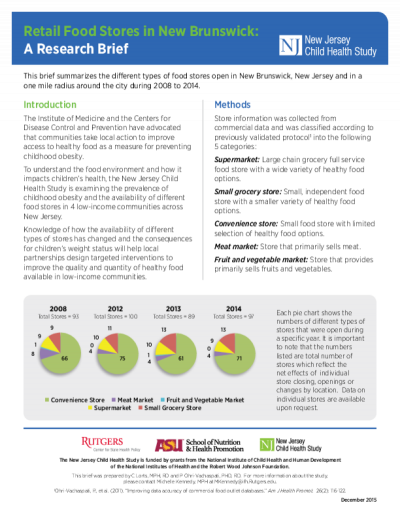
Disparities in healthy food access are well documented in cross-sectional studies in communities across the United States. However, longitudinal studies examining changes in food environments within various neighborhood contexts are scarce. In a sample of 142 census tracts in four low-income, high-minority cities in New Jersey, United States, we examined the availability of different types of food stores by census tract characteristics over time (2009–2017). Outlets were classified as supermarkets, small grocery stores, convenience stores, and pharmacies using multiple sources of data and a rigorous protocol. Census tracts were categorized by median household income and race/ethnicity of the population each year. Significant declines were observed in convenience store prevalence in lower- and medium-income and majority black tracts (p for trend: 0.004, 0.031, and 0.006 respectively), while a slight increase was observed in the prevalence of supermarkets in medium-income tracts (p for trend: 0.059). The decline in prevalence of convenience stores in lower-income and minority neighborhoods is likely attributable to declining incomes in these already poor communities. Compared to non-Hispanic neighborhoods, Hispanic communities had a higher prevalence of small groceries and convenience stores. This higher prevalence of smaller stores, coupled with shopping practices of Hispanic consumers, suggests that efforts to upgrade smaller stores in Hispanic communities may be more sustainable.

Objective: The Social Ecological Model (SEM) has been used to describe the aetiology of childhood obesity and to develop a framework for prevention. The current paper applies the SEM to data collected at multiple levels, representing different layers of the SEM, and examines the unique and relative contribution of each layer to children's weight status.
Design: Cross-sectional survey of randomly selected households with children living in low-income diverse communities.
Setting: A telephone survey conducted in 2009-2010 collected information on parental perceptions of their neighbourhoods, and household, parent and child demographic characteristics. Parents provided measured height and weight data for their children. Geocoded data were used to calculate proximity of a child's residence to food and physical activity outlets.
Subjects: Analysis based on 560 children whose parents participated in the survey and provided measured heights and weights.
Results: Multiple logistic regression models were estimated to determine the joint contribution of elements within each layer of the SEM as well as the relative contribution of each layer. Layers of the SEM representing parental perceptions of their neighbourhoods, parent demographics and neighbourhood characteristics made the strongest contributions to predicting whether a child was overweight or obese. Layers of the SEM representing food and physical activity environments made smaller, but still significant, contributions to predicting children's weight status.
Conclusions: The approach used herein supports using the SEM for predicting child weight status and uncovers some of the most promising domains and strategies for childhood obesity prevention that can be used for designing interventions.

Many factors influence children’s health behaviors and health outcomes. The Social Ecological Model (SEM) groups these factors into interactive layers, creating a framework for understanding their influence and for designing interventions to achieve positive change. The layers of influence in the SEM include individual, interpersonal, organizational, community, and policy factors.


This brief summarizes the different types of food stores open in New Brunswick, New Jersey and in a one mile radius around the city during 2008 to 2014.

Many factors influence children’s health behaviors and health outcomes. The Social Ecological Model (SEM) groups these factors into interactive layers, creating a framework for understanding their influence and for designing interventions to achieve positive change. The layers of influence in the SEM include individual, interpersonal, organizational, community, and policy factors (see figure). The New Jersey Child Health Study (NJCHS) was designed to examine how specific layers of the SEM, particularly food and physical activity environments in schools and communities, affect obesity outcomes in children

This brief summarizes the different types of food stores open in Camden, New Jersey and in a one mile radius around the city during 2008 to 2014.

This brief summarizes the different types of food stores open in Newark, New Jersey and in a one mile radius around the city during 2008 to 2014.

This brief summarizes the different types of food stores open in Trenton, New Jersey and in a one mile radius around the city during 2008 to 2014.

Meatless Monday is an initiative that encourages actionable steps toward the reduction of meat consumption by asking participants to eat meat-free on Mondays. Many organizations, cities, schools, and correctional facilities have implemented Meatless Monday initiatives as a push to improve environmental sustainability, human health, and the welfare of animals. Such initiatives provide an opportunity to educate consumers on the health benefits of a plant-forward diet, the environmental impact of meat production, animal welfare issues, the innovation of non-meat proteins, and to engage stakeholders in gaining more control over their food choices. This report offers a summary of seven Meatless Monday initiatives throughout the U.S., highlighting best practices and notable challenges of implementing and maintaining such an initiative in three different contexts: local government, school systems, and non-profit or volunteer-led organizations. This report was conducted through an extensive look at previous research, news articles, and marketing materials, as well as interviews with stakeholders in six mid-sized U.S. cities.